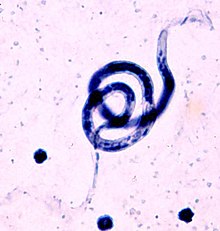| Brugia | |
|---|---|

| |
| B. malayi from blood smear using Giemsa stain. | |
| Scientific classification | |
| Domain: | Eukaryota |
| Kingdom: | Animalia |
| Phylum: | Nematoda |
| Class: | Chromadorea |
| Order: | Rhabditida |
| Family: | Onchocercidae |
| Genus: | Brugia Buckley, 1960 |
| Species | |
Brugia is a genus for a group of small roundworms. They are among roundworms that cause the parasitic disease filariasis.[1] Specifically, of the three species known, Brugia malayi and Brugia timori cause lymphatic filariasis in humans; and Brugia pahangi and Brugia patei infect domestic cats, dogs and other animals.[2][3] They are transmitted by the bite of mosquitos.[4]
- ^ Sudomo, M; Chayabejara, S; Duong, S; Hernandez, L; Wu, WP; Bergquist, R (2010). "Elimination of lymphatic filariasis in Southeast Asia". Advances in Parasitology. 72: 205–233. doi:10.1016/S0065-308X(10)72008-X. ISBN 9780123815132. PMID 20624533.
- ^ Mak, JW; Navaratnam, V; Ramachandran, CP (1991). "Experimental chemotherapy of lymphatic filariasis. A review". Annals of Tropical Medicine and Parasitology. 85 (1): 131–137. doi:10.1080/00034983.1991.11812539. PMID 1888210.
- ^ Vincent, Albert L.; Frommes, Stephen P.; Ash, Lawrence R. (1976). "Brugia malayi, Brugia pahangi, and Brugia patei: Pulmonary pathology in jirds, Meriones unguiculatus". Experimental Parasitology. 40 (3): 330–354. doi:10.1016/0014-4894(76)90100-4. PMID 976421.
- ^ Townson, H; Chaithong, U (1991). "Mosquito host influences on development of filariae". Annals of Tropical Medicine and Parasitology. 85 (1): 149–163. doi:10.1080/00034983.1991.11812541. PMID 1888212.